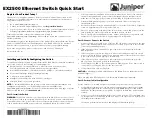
592
Configuring QoS
QoS Treatment for Performance-Monitoring Protocols
QoS Queuing for CPU-Generated Traffic
You can use the QoS markings established for the CPU-generated traffic by the
cpu traffic qos
global configuration
command as packet identifiers in the class-map of an output policy-map to map CPU traffic to class-queues in the output
policy-map on the egress port. You can then use output policy-maps on the egress port to configure queuing and
scheduling for traffic leaving the switch from that port.
If you want to map
all
CPU-generated traffic to a single class in the output policy-maps without changing the CoS, IP
DSCP, or IP-precedence packet markings, you can use QoS groups for marking CPU-generated traffic.
If you want to map
all
CPU-generated IP traffic to classes in the output policy maps based on IP-DSCP or IP precedence
without changing those packet markings, you can use a table map:
Configure IP-DSCP or IP precedence marking by using
DSCP
or
precedence
as the
map
from
value
without
a table
map.
Configure IP-DSCP or IP-precedence marking by using
DSCP
or
precedence
as the
map
from
value
with
a table
map, using only the
default
and
copy
keywords.
If you want to map
all
CPU-generated traffic to classes in the output policy maps based on the CoS without changing
the CoS packet markings, you can use the table map:
Configure CoS marking by using
CoS
as the
map
from
value
without
a table map.
Configure CoS marking using
CoS
as the
map
from
value
with
a table map, using only the
default
and
copy
keywords.
For details about table maps, see
Using the
cpu traffic qos
global configuration command with table mapping, you can configure multiple marking and
queuing policies to work together or independently. You can queue native VLAN traffic based on the CoS markings
configured using the
cpu traffic qos
global configuration command.
The
cpu traffic qos
command specifies the traffic to which it applies: all CPU traffic, only CPU-IP traffic, or only CPU
non-IP traffic. All other traffic is statically mapped to a CPU-default queue on the egress port. All CFM traffic (including
Layer 2 IP SLA probes using CFM) is mapped to classes in the output policy map and queued based on their CoS value.
Note:
The switch provides the ability to queue based on the CoS, IP-DSCP, and IP precedence of CPU-generated traffic.
Configuration Guidelines
This feature must be configured globally for a switch; it cannot be configured per-port or per-protocol.
Enter each
cpu traffic qos
marking action on a separate line.
The
cpu traffic qos cos
global configuration command configures CoS marking for CPU-generated traffic by using
either a specific CoS value or a table map, but not both. A new configuration overwrites the existing configuration.
The
cpu traffic qos dscp
global configuration command configures IP-DSCP marking for CPU-generated IP traffic
by using either a specific DSCP value or a table map, but not both. A new configuration overwrites the existing
configuration.
The
cpu traffic qos precedence
global configuration command configures IP-precedence marking for
CPU-generated IP traffic by using either a specific precedence value or a table map, but not both. A new
configuration overwrites the existing configuration.
The
cpu traffic qos dscp
and
cpu traffic qos precedence
global configuration commands are mutually exclusive.
A new configuration overwrites the existing configuration.
Содержание IE 4000
Страница 12: ...8 Configuration Overview Default Settings After Initial Switch Configuration ...
Страница 52: ...48 Configuring Interfaces Monitoring and Maintaining the Interfaces ...
Страница 108: ...104 Configuring Switch Clusters Additional References ...
Страница 128: ...124 Performing Switch Administration Additional References ...
Страница 130: ...126 Configuring PTP ...
Страница 140: ...136 Configuring CIP Additional References ...
Страница 146: ...142 Configuring SDM Templates Configuration Examples for Configuring SDM Templates ...
Страница 192: ...188 Configuring Switch Based Authentication Additional References ...
Страница 244: ...240 Configuring IEEE 802 1x Port Based Authentication Additional References ...
Страница 274: ...270 Configuring SGT Exchange Protocol over TCP SXP and Layer 3 Transport Configuring Cisco TrustSec Caching ...
Страница 298: ...294 Configuring VLANs Additional References ...
Страница 336: ...332 Configuring STP Additional References ...
Страница 408: ...404 Configuring DHCP Additional References ...
Страница 450: ...446 Configuring IGMP Snooping and MVR Additional References ...
Страница 490: ...486 Configuring SPAN and RSPAN Additional References ...
Страница 502: ...498 Configuring Layer 2 NAT ...
Страница 559: ...555 Configuring Network Security with ACLs How to Configure Network Security with ACLs Creating a Numbered Extended ACL ...
Страница 770: ...766 Configuring IPv6 MLD Snooping Related Documents ...
Страница 930: ...926 Configuring IP Unicast Routing Related Documents ...
Страница 956: ...952 Configuring IPv6 Unicast Routing Configuring IPv6 network 2010 AB8 2 48 network 2010 AB8 3 48 exit address family ...
Страница 976: ...972 Configuring Cisco IOS IP SLAs Operations Additional References ...
Страница 978: ...974 Dying Gasp ...
Страница 990: ...986 Configuring Enhanced Object Tracking Monitoring Enhanced Object Tracking ...
Страница 994: ...990 Configuring MODBUS TCP Displaying MODBUS TCP Information ...
Страница 996: ...992 Ethernet CFM ...
Страница 1030: ...1026 Working with the Cisco IOS File System Configuration Files and Software Images Working with Software Images ...
Страница 1066: ...1062 Using an SD Card SD Card Alarms ...
















































